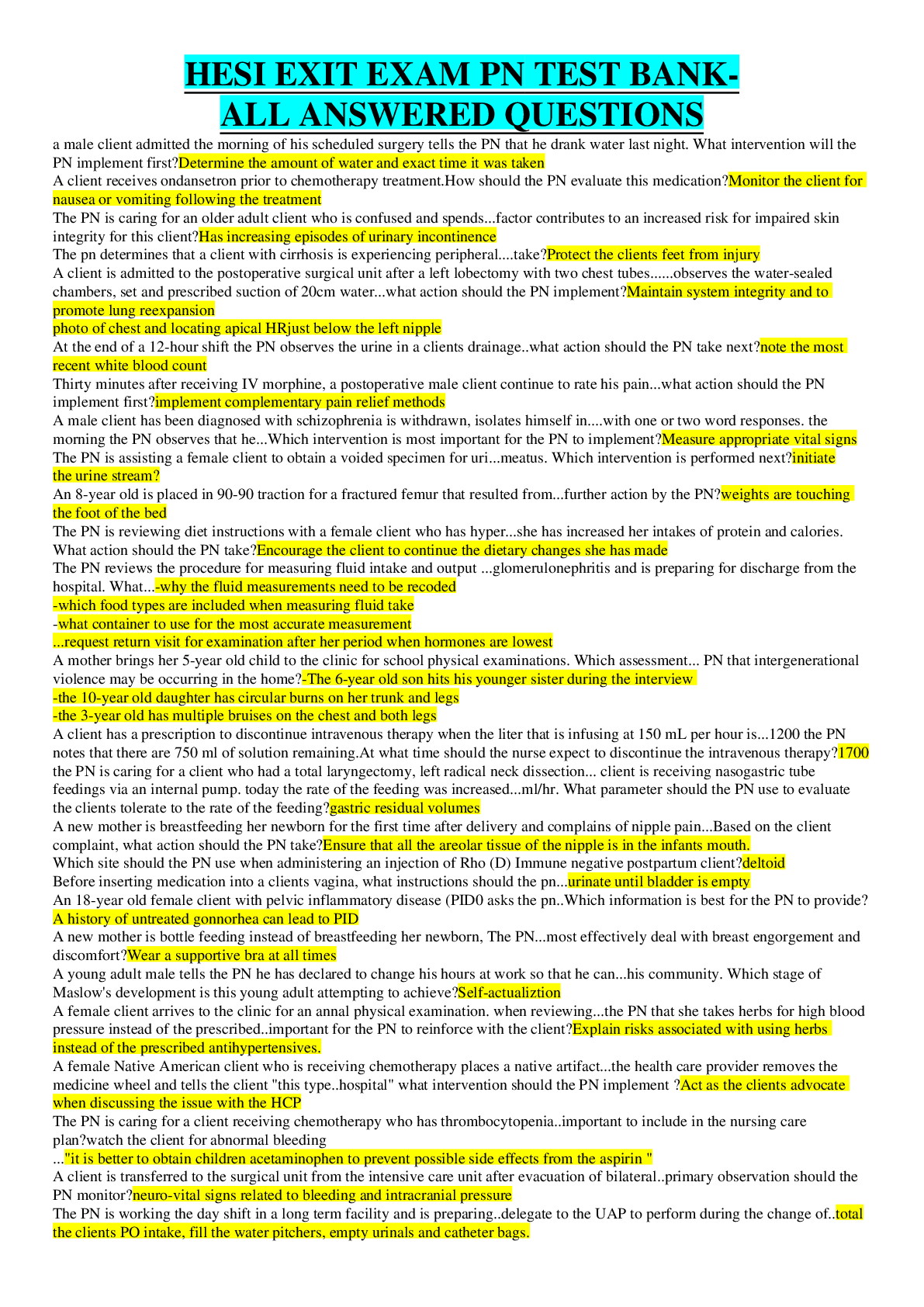HEALTH ASSESSMENT HESI QUESTION BANK (100% CORRECT ANSWERS)
Document Content and Description Below
HEALTH ASSESSMENT HESI QUESTION BANK (100% CORRECT ANSWERS) 31. During a mental status assessment, which question by the nurse would best assess a person's judgment? A) "Do you feel that you are... being watched, followed, or controlled?" B) "Tell me about what you plan to do once you are discharged from the hospital." C) "What does the statement, 'People in glass houses shouldn't throw stones,' mean to you?" D) "What would you do if you found a stamped, addressed envelope lying on the sidewalk?" B) "Tell me about what you plan to do once you are discharged from the hospital." Pages: 76-77. A person exercises judgment when he or she can compare and evaluate the alternatives in a situation and reach an appropriate course of action. Rather than testing the person's response to a hypothetical situation (as illustrated in the option with the envelope), the nurse should be more interested in the person's judgment about daily or long-term goals, the likelihood of acting in response to delusions or hallucinations and the capacity for violent or suicidal behavior. 32. The nurse is performing a mental status examination. Which statement is true regarding the assessment of mental status? A) Mental status assessment diagnoses specific psychiatric disorders. B) Mental disorders occur in response to everyday life stressors. C) Mental status functioning is inferred through assessment of an individual's behaviors. D) Mental status can be assessed directly, just like other systems of the body (e.g., cardiac and breath sounds). C) Mental status functioning is inferred through assessment of an individual's behaviors. Page: 71. Mental status functioning is inferred through assessment of an individual's behaviors. It cannot be assessed directly like characteristics of the skin or heart sounds. 33. When performing a physical assessment, the technique the nurse will always use first is: A) palpation. B) inspection. C) percussion. D) auscultation. B) inspection. Pages: 115-116. The skills requisite for the physical examination are inspection, palpation, percussion, and auscultation. The skills are performed one at a time and in this order (with the exception of the abdominal assessment, where auscultation takes place before palpation and percussion). The assessment of each body system begins with inspection. A focused inspection takes time and yields a surprising amount of information. 34. The nurse is assessing a patient's skin during an office visit. What is the best technique to use to best assess the patient's skin temperature? Use the: A) fingertips because they're more sensitive to small changes in temperature. B) dorsal surface of the hand because the skin is thinner than on the palms. C) ulnar portion of the hand because there is increased blood supply that enhances temperature sensitivity. D) palmar surface of the hand because it is most sensitive to temperature variations because of increased nerve supply in this area. B) dorsal surface of the hand because the skin is thinner than on the palms. The dorsa (backs) of hands and fingers are best for determining temperature because the skin there is thinner than on the palms. Fingertips are best for fine, tactile discrimination; the other responses are not useful for palpation. 35. The nurse is preparing to assess a patient's abdomen by palpation. How should the nurse proceed? A) Avoid palpation of reported "tender" areas because this may cause the patient pain. B) Quickly palpate a tender area to avoid any discomfort that the patient may experience. C) Begin the assessment with deep palpation, encouraging the patient to relax and take deep breaths. D) Start with light palpation to detect surface characteristics and to accustom the patient to being touched. D) Start with light palpation to detect surface characteristics and to accustom the patient to being touched. Pages: 115-116. Light palpation is performed initially to detect any surface characteristics and to accustom the person to being touched. Tender areas should be palpated last, not first. 36. The nurse would use bimanual palpation technique in which situation? A) Palpating the thorax of an infant B) Palpating the kidneys and uterus C) Assessing pulsations and vibrations D) Assessing the presence of tenderness and pain B) Palpating the kidneys and uterus Pages: 115-116. Bimanual palpation requires the use of both hands to envelop or capture certain body parts or organs such as the kidneys, uterus, or adnexa. The other situations are not appropriate for bimanual palpation. 37. When percussing over the liver of a patient, the nurse notices a dull sound. The nurse should: A) consider this a normal finding. B) palpate this area for an underlying mass. C) reposition the hands and attempt to percuss in this area again. D) consider this an abnormal finding and refer the patient for additional treatment. A) consider this a normal finding. Pages: 116-117. Percussion over relatively dense organs, such as the liver or spleen, will produce a dull sound. The other responses are not correct. We have an expert-written solution to this problem! 38. The nurse is unable to palpate the right radial pulse on a patient. The best action would be to: A) auscultate over the area with a fetoscope. B) use a goniometer to measure the pulsations. C) use a Doppler device to check for pulsations over the area. D) check for the presence of pulsations with a stethoscope. C) use a Doppler device to check for pulsations over the area. Page: 120. Doppler devices are used to augment pulse or blood pressure measurements. Goniometers measure joint range of motion. A fetoscope is used to auscultate fetal heart tones. Stethoscopes are used to auscultate breath, bowel, and heart sounds. 39. When performing a physical examination, safety must be considered to protect the examiner and the patient against the spread of infection. Which of these statements describes the most appropriate action the nurse should take when performing a physical examination? A) There is no need to wash one's hands after removing gloves, as long as the gloves are still intact. B) Wash hands before and after every physical patient encounter. C) Wash hands between the examination of each body system to prevent the spread of bacteria from one part of the body to another. D) Wear gloves throughout the entire examination to demonstrate to the patient concern regarding the spread of infectious diseases. B) Wash hands before and after every physical patient encounter. Page: 120. The nurse should wash his or her hands before and after every physical patient encounter; after contact with blood, body fluids, secretions, and excretions; after contact with any equipment contaminated with body fluids; and after removing gloves. Hands should be washed after gloves have been removed, even if the gloves appear to be intact. Gloves should be worn when there is potential contact with any body fluids. 40. The nurse is examining an infant and prepares to elicit the Moro reflex at which time during the examination? A) When the infant is sleeping B) At the end of the examination C) Before auscultation of the thorax D) Halfway through the examination B) At the end of the examination Page: 123. Elicit the Moro or "startle" reflex at the end of the examination because it may cause the infant to cry. 41. A 6-month-old infant has been brought to the well-child clinic for a check-up. She is currently sleeping. What should the nurse do first when beginning the examination? A) Auscultate the lungs and heart while the infant is still sleeping. B) Examine the infant's hips because this procedure is uncomfortable. C) Begin with the assessment of the eye and continue with the remainder of the examination in a head-to-toe approach. D) Wake the infant before beginning any portion of the examination to obtain the most accurate assessment of body systems. A) Auscultate the lungs and heart while the infant is still sleeping. Pages: 122-124. When the infant is quiet or sleeping is an ideal time to assess the cardiac, respiratory, and abdominal systems. Assessment of the eye, ear, nose, and throat are invasive procedures and should be performed at the end of the examination. 42. The nurse is assessing an 80-year-old male patient. Which assessment findings would be considered normal? A) An increase in body weight from younger years B) Additional deposits of fat on the thighs and lower legs C) The presence of kyphosis and flexion in the knees and hips D) A change in overall body proportion, a longer trunk, and shorter extremities C) The presence of kyphosis and flexion in the knees and hips Page: 149. Changes that occur in the aging person include more prominent bony landmarks, decreased body weight (especially in males), a decrease in subcutaneous fat from the face and periphery, and additional fat deposited on the abdomen and hips. Postural changes of kyphosis and slight flexion in the knees and hips also occur. 43. When assessing the force, or strength, of a pulse, the nurse recalls that it: A) is usually recorded on a 0- to 2-point scale. B) demonstrates elasticity of the vessel wall. C) is a reflection of the heart's stroke volume. D) reflects the blood volume in the arteries during diastole. C) is a reflection of the heart's stroke volume. Page: 134. The heart pumps an amount of blood (the stroke volume) into the aorta. The force flares the arterial walls and generates a pressure wave, which is felt in the periphery as the pulse. 44. When assessing the quality of a patient's pain, the nurse should ask which question? A) "When did the pain start?" B) "Is the pain a stabbing pain?" C) "Is it a sharp pain or dull pain?" D) "What does your pain feel like?" D) "What does your pain feel like?" Page: 164. To assess the quality of a person's pain, have the patient describe the pain in his or her own words. 45. The nurse is providing care for a 68-year-old woman who is complaining of constipation. What concern exists regarding her nutritional status? A) The absorption of nutrients may be impaired. B) The constipation may represent a food allergy. C) She may need emergency surgery for the problem. D) The gastrointestinal problem will increase her caloric demand. A) The absorption of nutrients may be impaired. Page: 182. Gastrointestinal symptoms such as vomiting, diarrhea, or constipation may interfere with nutrient intake or absorption. The other responses are not correct. 46. During a nutritional assessment, why is it important for the nurse to ask a patient what medications he or she is taking? A) Certain drugs can affect the metabolism of nutrients. B) The nurse needs to assess the patient for allergic reactions. C) Medications need to be documented on the record for the physician's review. D) Medications can affect one's memory and ability to identify food eaten in the last 24 hours. A) Certain drugs can affect the metabolism of nutrients. Page: 183 Analgesics, antacids, anticonvulsants, antibiotics, diuretics, laxatives, antineoplastic drugs, steroids, and oral contraceptives are drugs that can interact with nutrients, impairing their digestion, absorption, metabolism, or use. The other responses are not correct. 47. The nurse is reviewing the nutritional assessment of an 82-year-old patient. Which of these factors is most likely to affect the nutritional status of an elderly person? A) Increase in taste and smell B) Living alone on a fixed income C) Change in cardiovascular status D) Increase in gastrointestinal motility and absorption B) Living alone on a fixed income Page: 176. Socioeconomic conditions frequently affect the nutritional status of the aging adult; these factors should be closely evaluated. Physical limitations, income, and social isolation are frequent problems that interfere with the acquisition of a balanced diet. A decrease in taste and smell and decreased gastrointestinal motility and absorption occur with aging. Cardiovascular status is not a factor that affects an elderly person's nutritional status. We have an expert-written solution to this problem! 48. When the mid-upper arm circumference and triceps skinfold of an 82-year-old man are evaluated, which is important for the nurse to remember? A) These measurements are no longer necessary for the elderly. B) Derived weight measures may be difficult to interpret because of wide ranges of normal. C) These measurements may not be accurate because of changes in skin and fat distribution. D) Measurements may be difficult to obtain if the patient is unable to flex his elbow to at least 90 degrees. C) These measurements may not be accurate because of changes in skin and fat distribution. Page: 191 Accurate mid-upper arm circumference and triceps skinfold measurements are difficult to obtain and interpret in older adults because of sagging skin, changes in fat distribution, and declining muscle mass. Body mass index and waist-to-hip ratio are better indicators of obesity in the elderly. We have an expert-written solution to this problem! 49. The nurse needs to perform anthropometric measures of an 80-year-old man who is confined to a wheelchair. Which of the following is true in this situation? A) Changes in fat distribution will affect the waist-to-hip ratio. B) Height measurements may not be accurate because of changes in bone. C) Declining muscle mass will affect the triceps skinfold measure. D) Mid-arm circumference is difficult to obtain because of loss of skin elasticity. B) Height measurements may not be accurate because of changes in bone. Page: 191. Height measures may not be accurate in individuals confined to a bed or wheelchair or those over 60 years of age because of osteoporotic changes. 50. The nurse is performing a nutritional assessment on an 80-year-old patient. The nurse knows that physiological changes that directly affect the nutritional status of the elderly include: A) slowed gastrointestinal motility. B) hyperstimulation of the salivary glands. C) an increased sensitivity to spicy and aromatic foods. D) decreased gastrointestinal absorption causing esophageal reflux. A) slowed gastrointestinal motility. Page: 176. Normal physiological changes in aging adults that affect nutritional status include slowed gastrointestinal motility, decreased gastrointestinal absorption, diminished olfactory and taste sensitivity, decreased saliva production, decreased visual acuity, and poor dentition. 51. The nurse keeps in mind that a thorough skin assessment is very important because the skin holds information about a person's: A) support systems. B) circulatory status. C) socioeconomic status. D) psychological wellness. B) circulatory status. Page: 211. The skin holds information about the body's circulation, nutritional status, and signs of systemic diseases as well as topical data on the integument itself. 52. A patient tells the nurse that he has noticed that one of his moles has started to burn and bleed. When assessing his skin, the nurse would pay special attention to the danger signs for pigmented lesions and would be concerned with which additional finding? A) Color variation B) Border regularity C) Symmetry of lesions D) Diameter less than 6 mm A) Color variation Pages: 212-213. Abnormal characteristics of pigmented lesions are summarized in the mnemonic ABCD: asymmetry of pigmented lesion, border irregularity, color variation, and diameter greater than 6 mm. [Show More]
Last updated: 7 months ago
Preview 1 out of 726 pages
Instant download
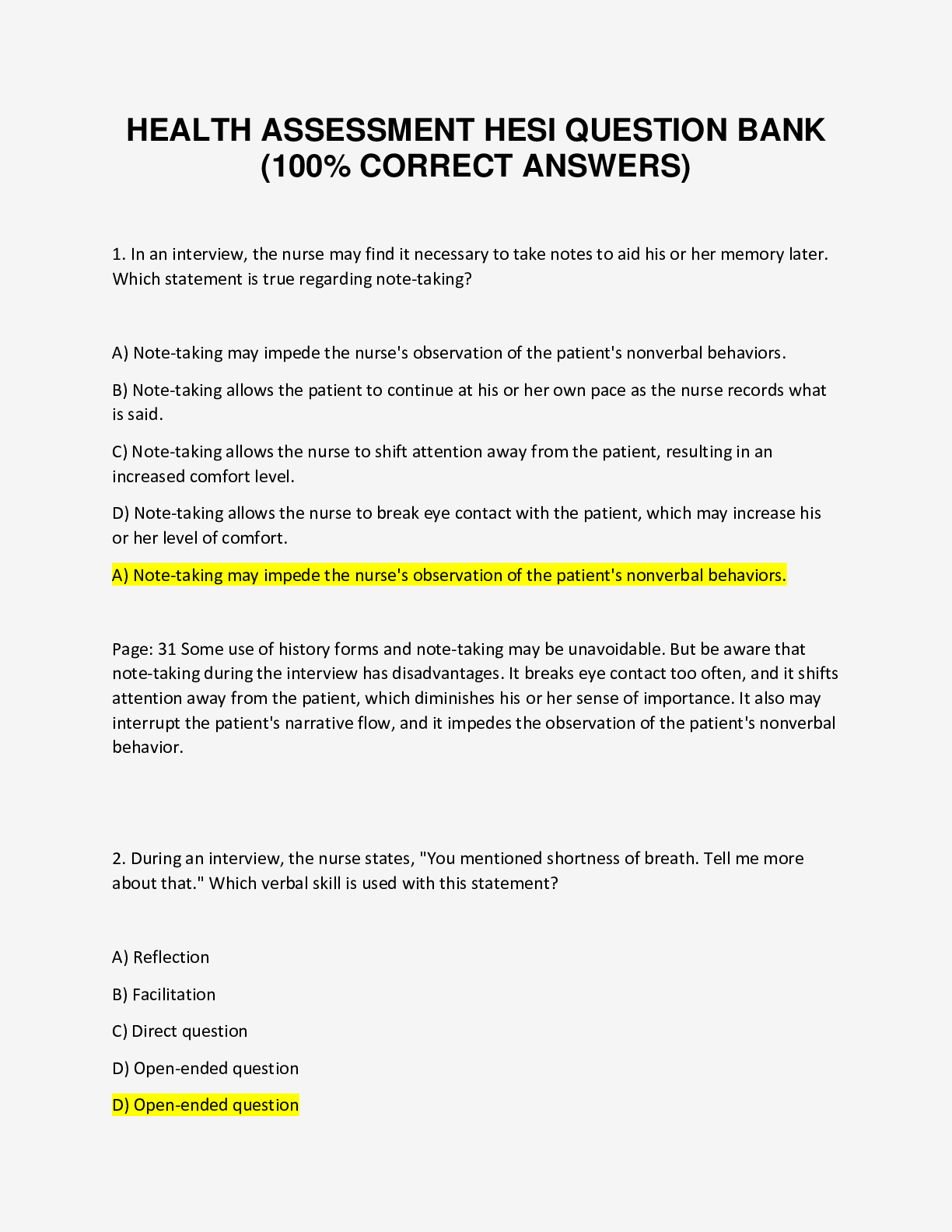
Instant download
Also available in bundle (1)

HESI Health Assessment Exams and Study Materials PACKAGE DEAL (100% Guaranteed Pass
HESI Health Assessment Exams and Study Materials PACKAGE DEAL (100% Guaranteed Pass
By A+ Solutions 7 months ago
$20.5
11
Reviews( 0 )
Document information
Connected school, study & course
About the document
Uploaded On
Oct 09, 2023
Number of pages
726
Written in
Additional information
This document has been written for:
Uploaded
Oct 09, 2023
Downloads
0
Views
124


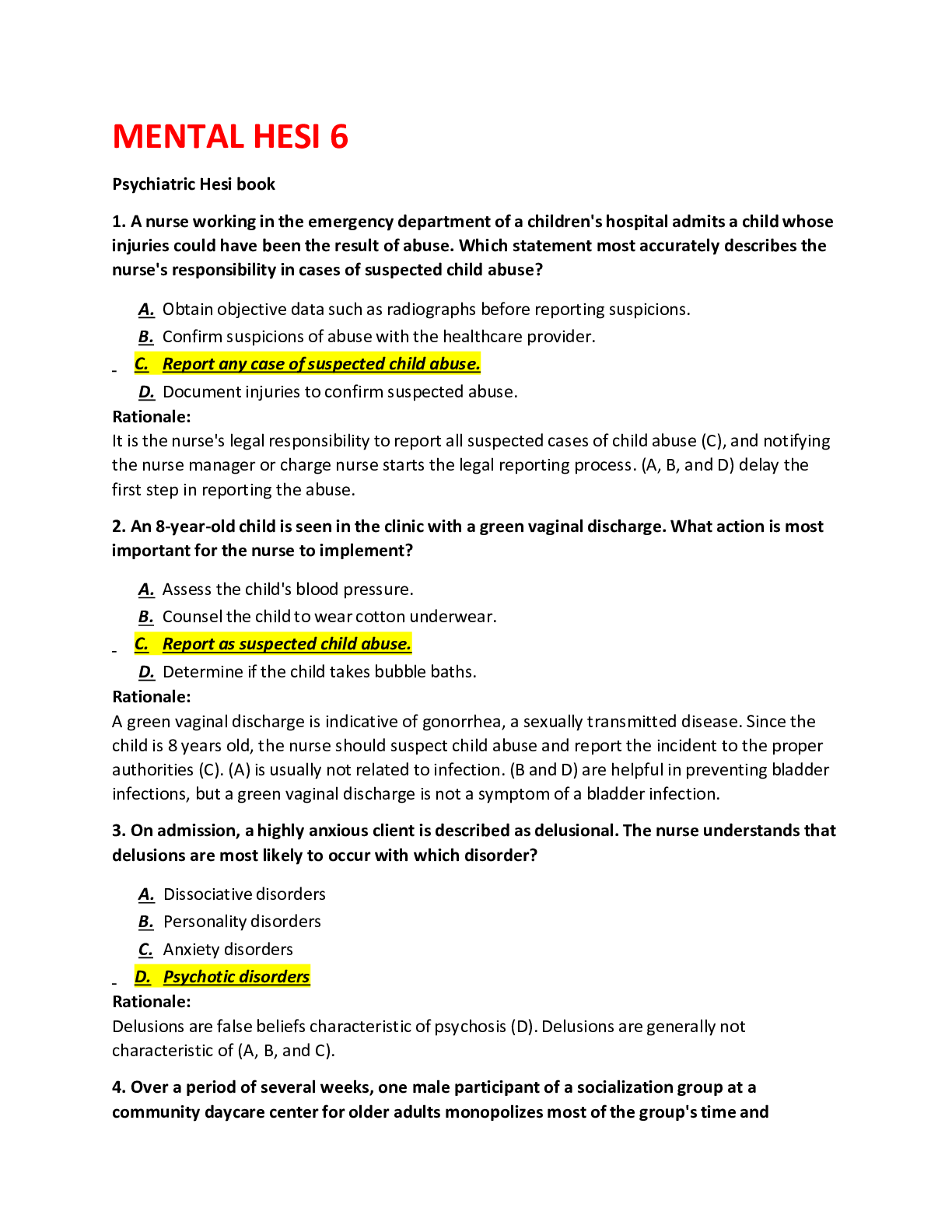
.png)


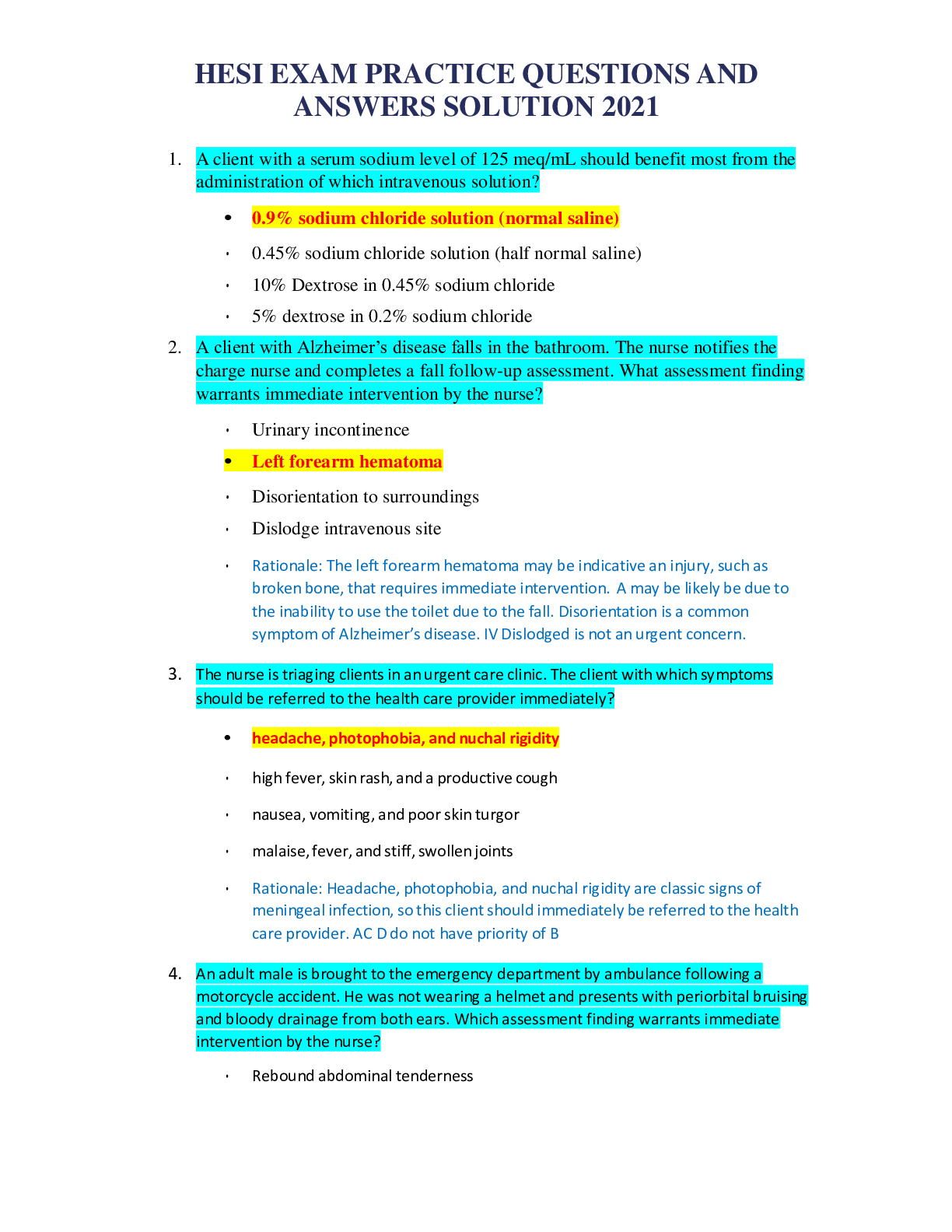
.png)
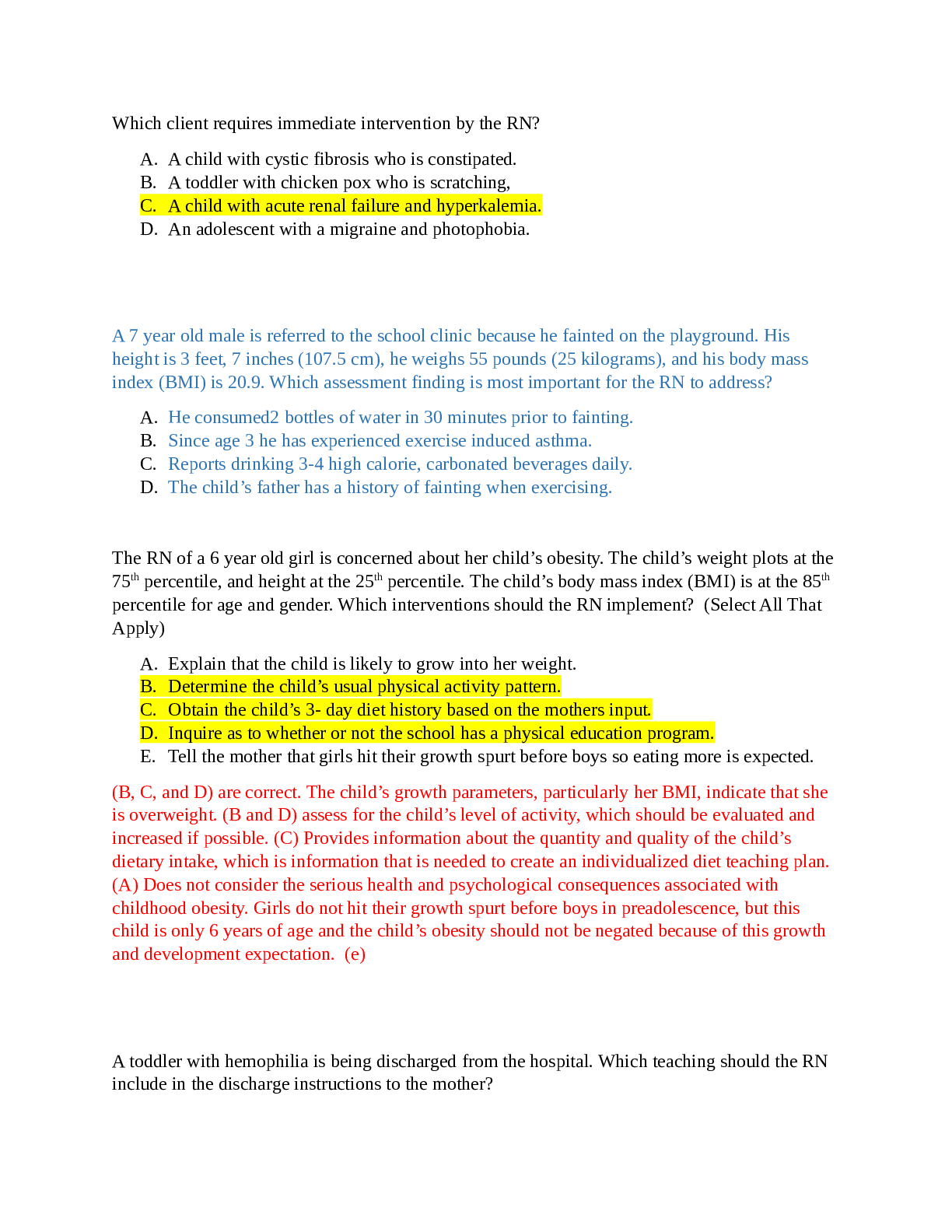



.png)
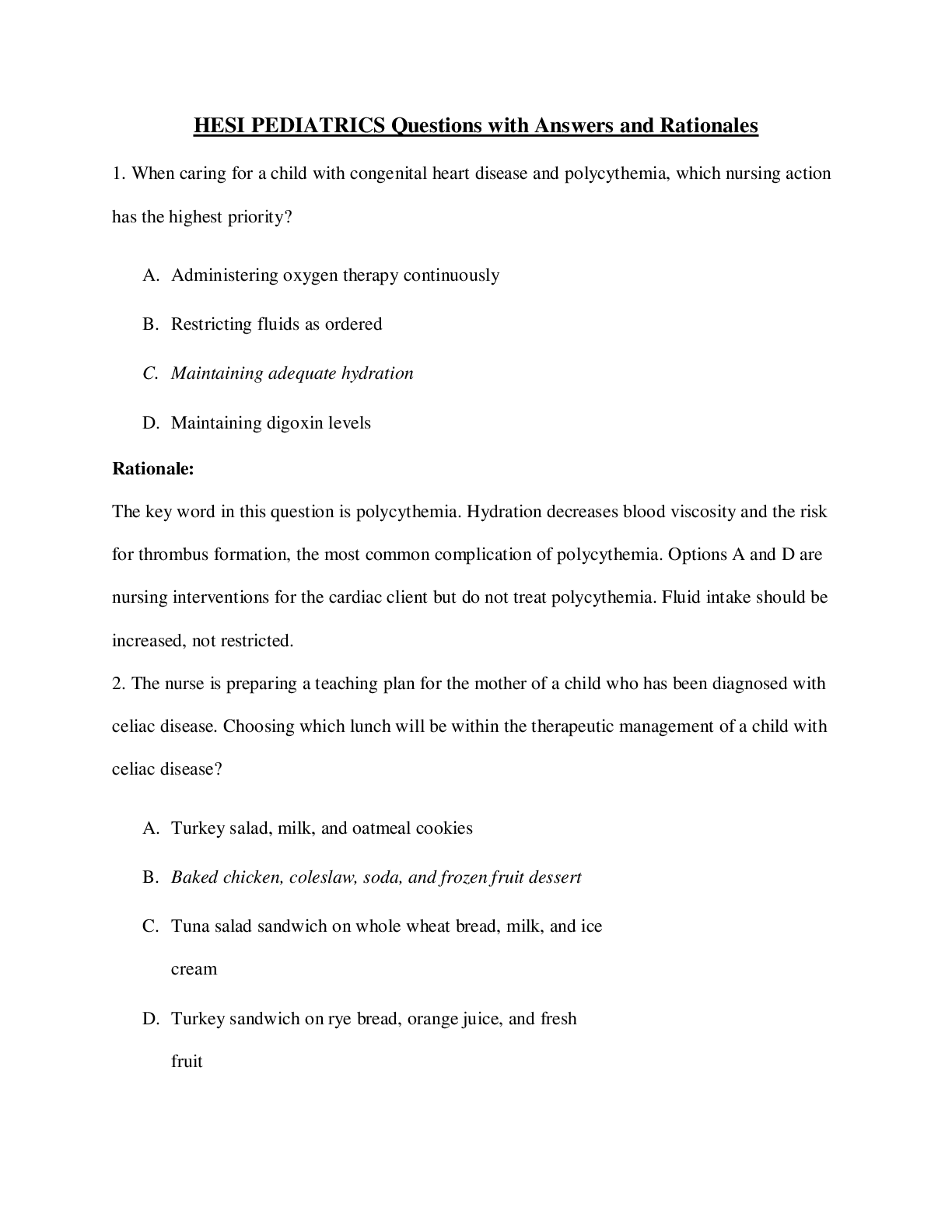
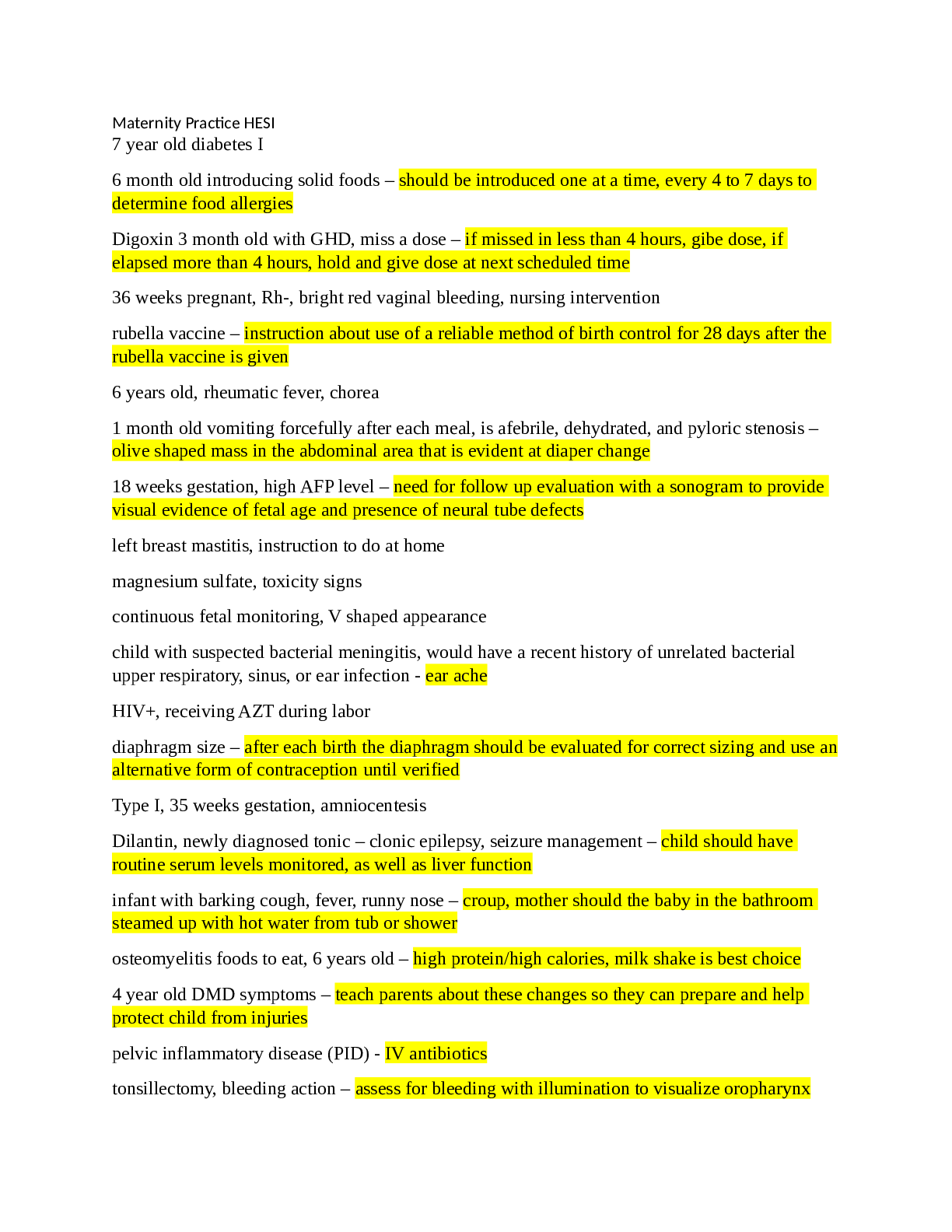

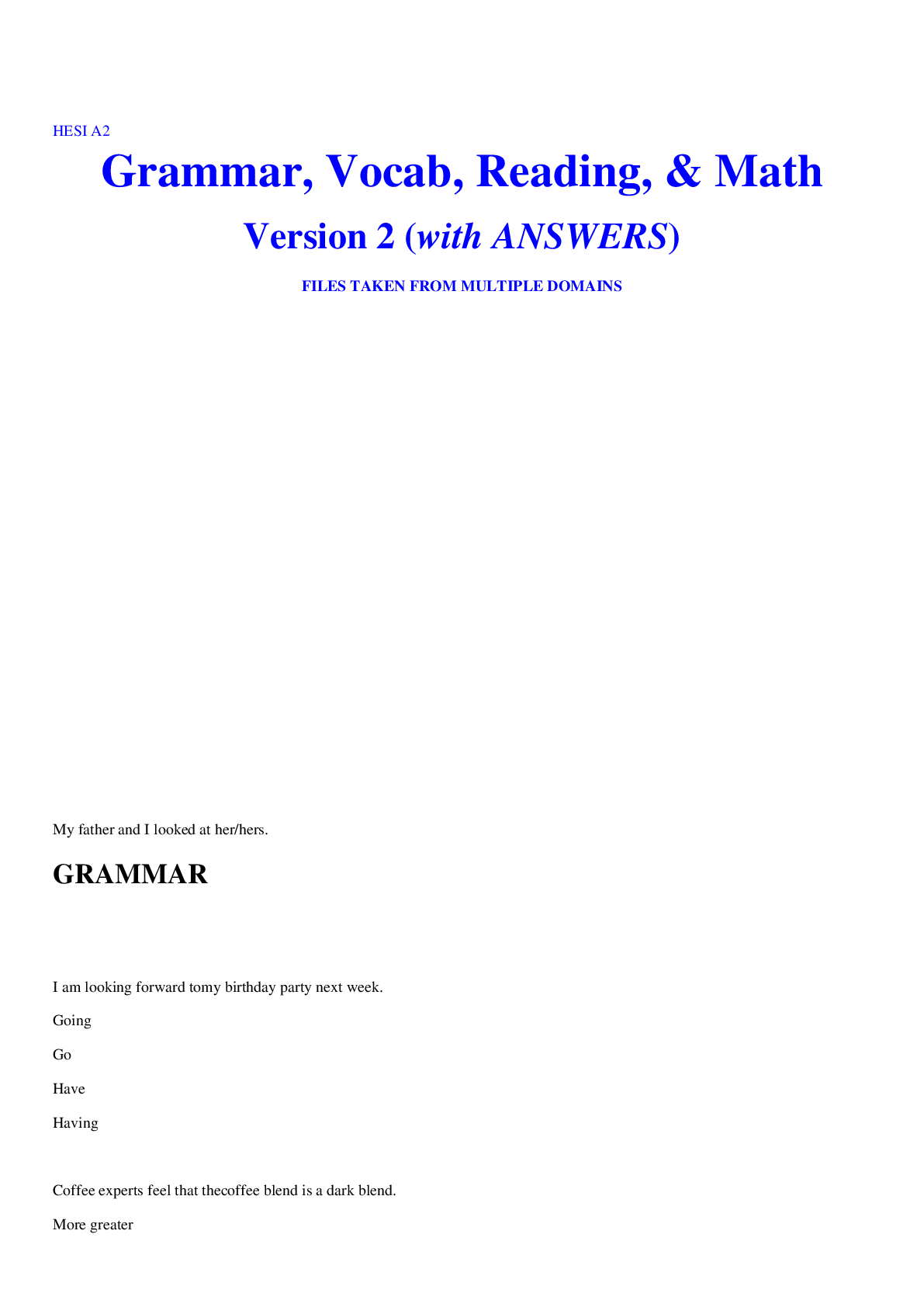
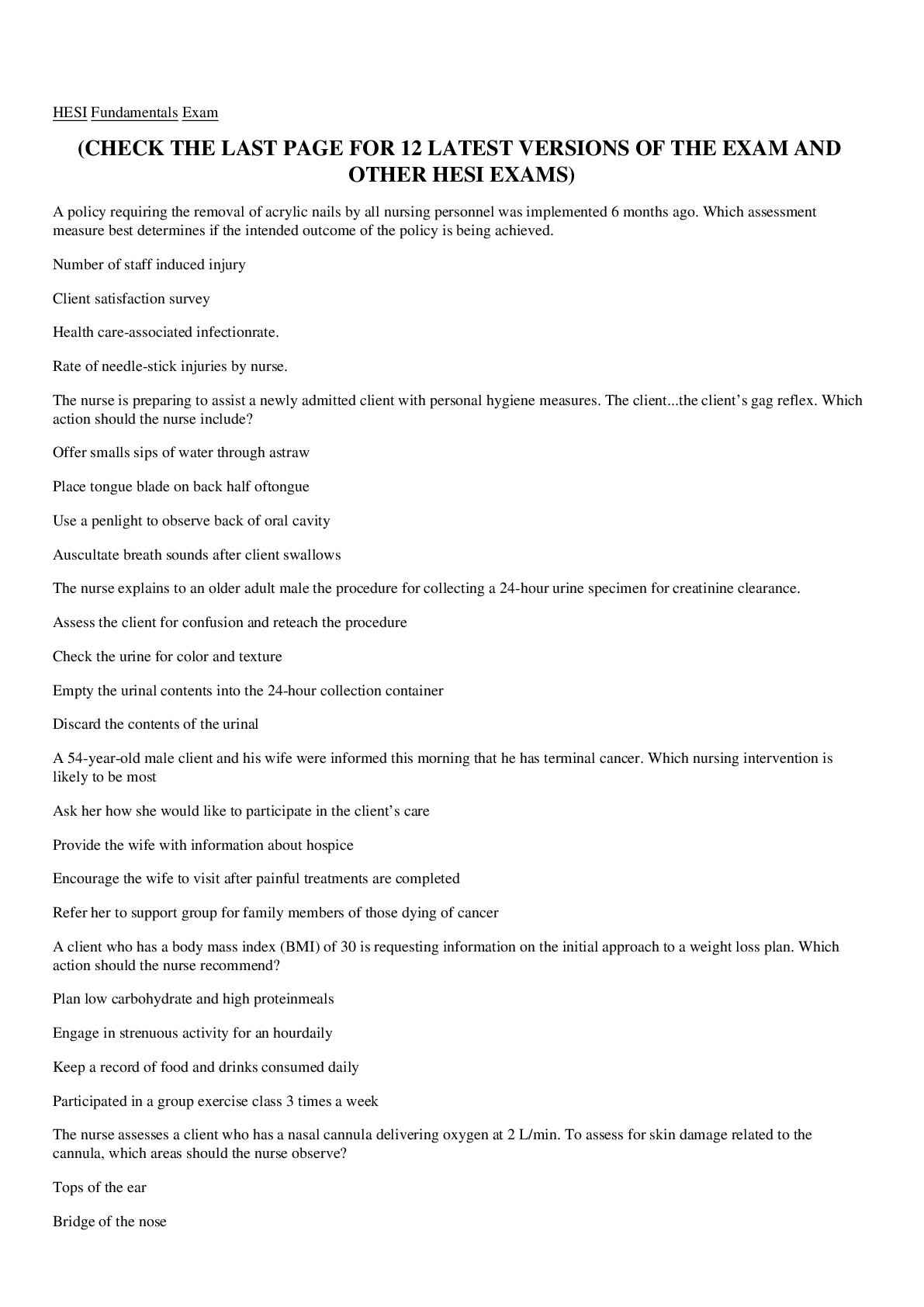
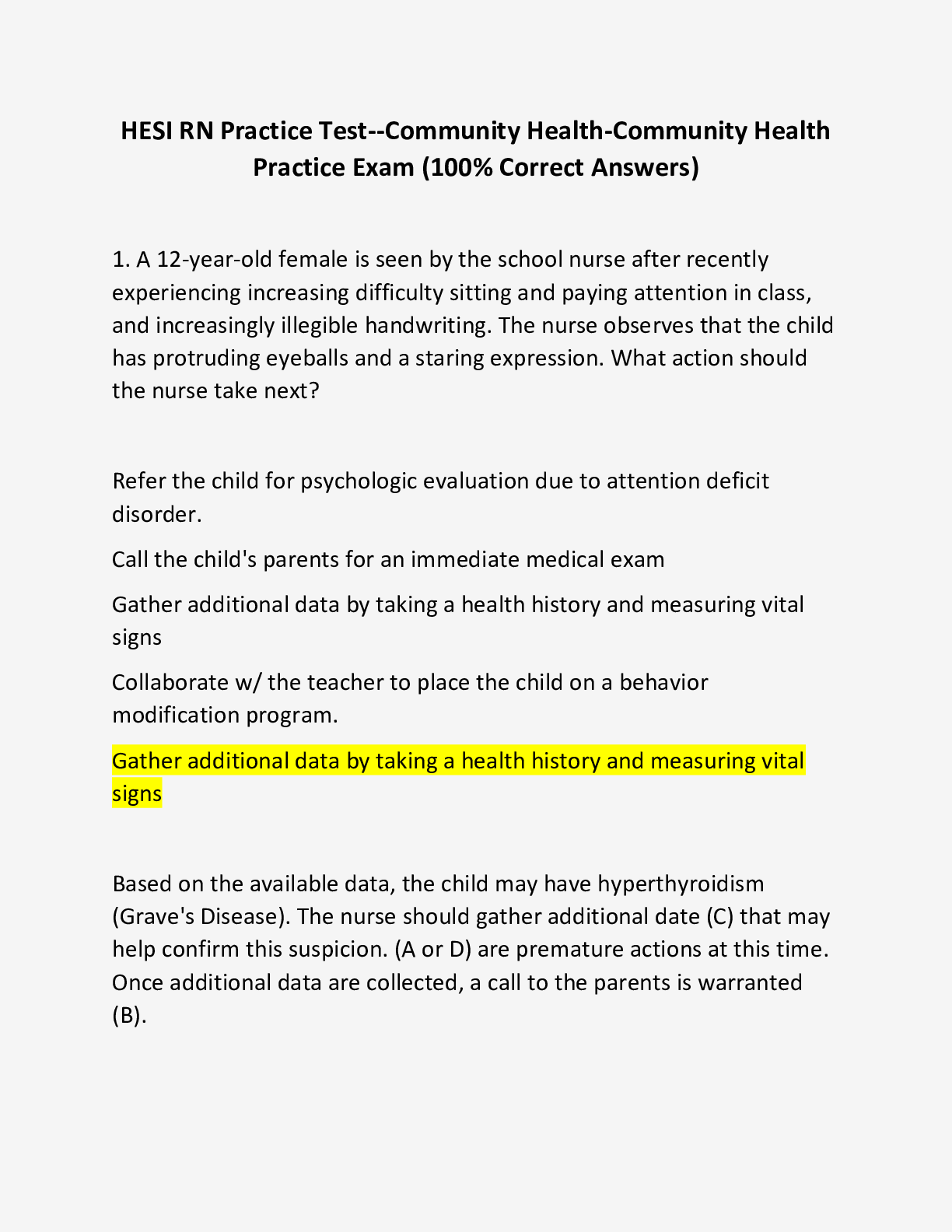


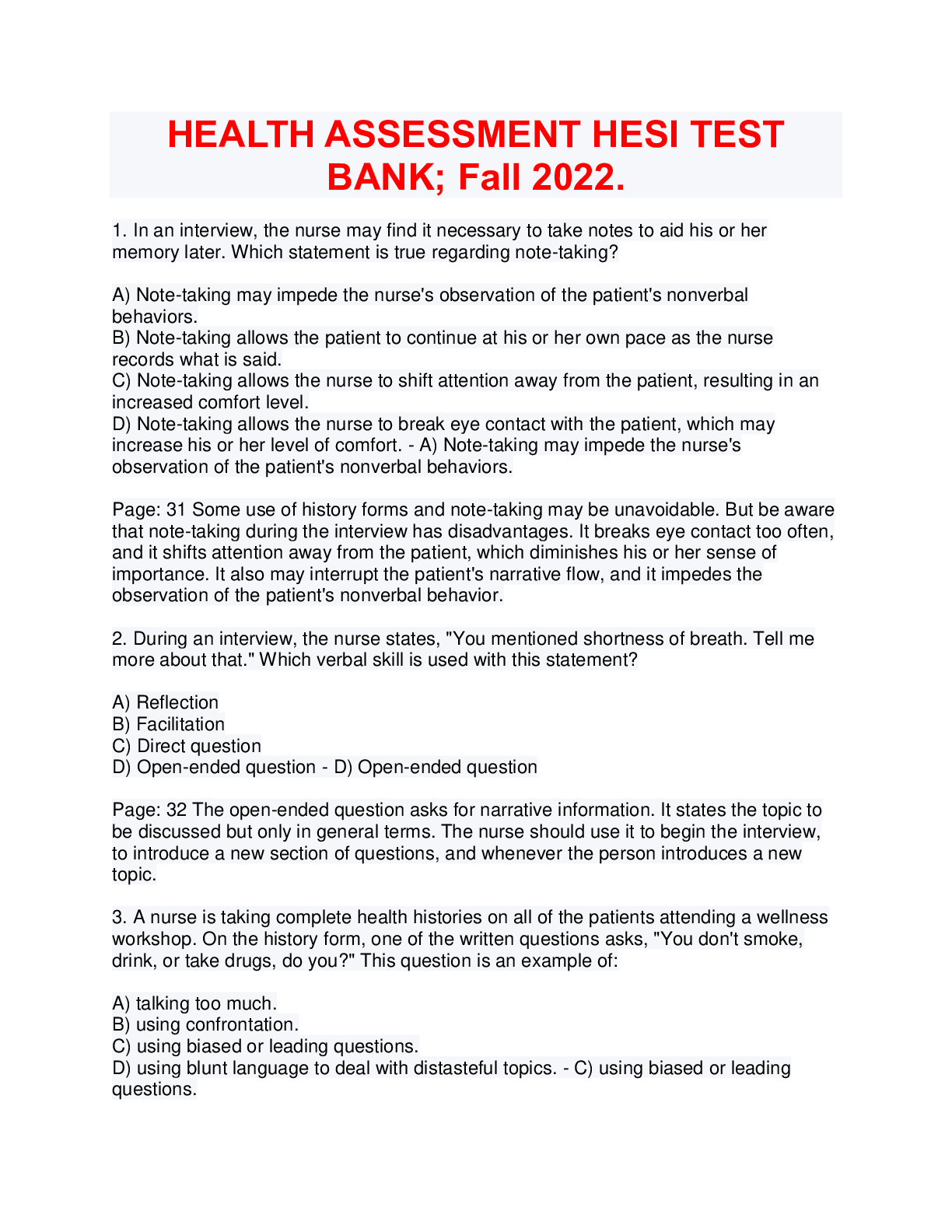
 Practice Test 2022.png)


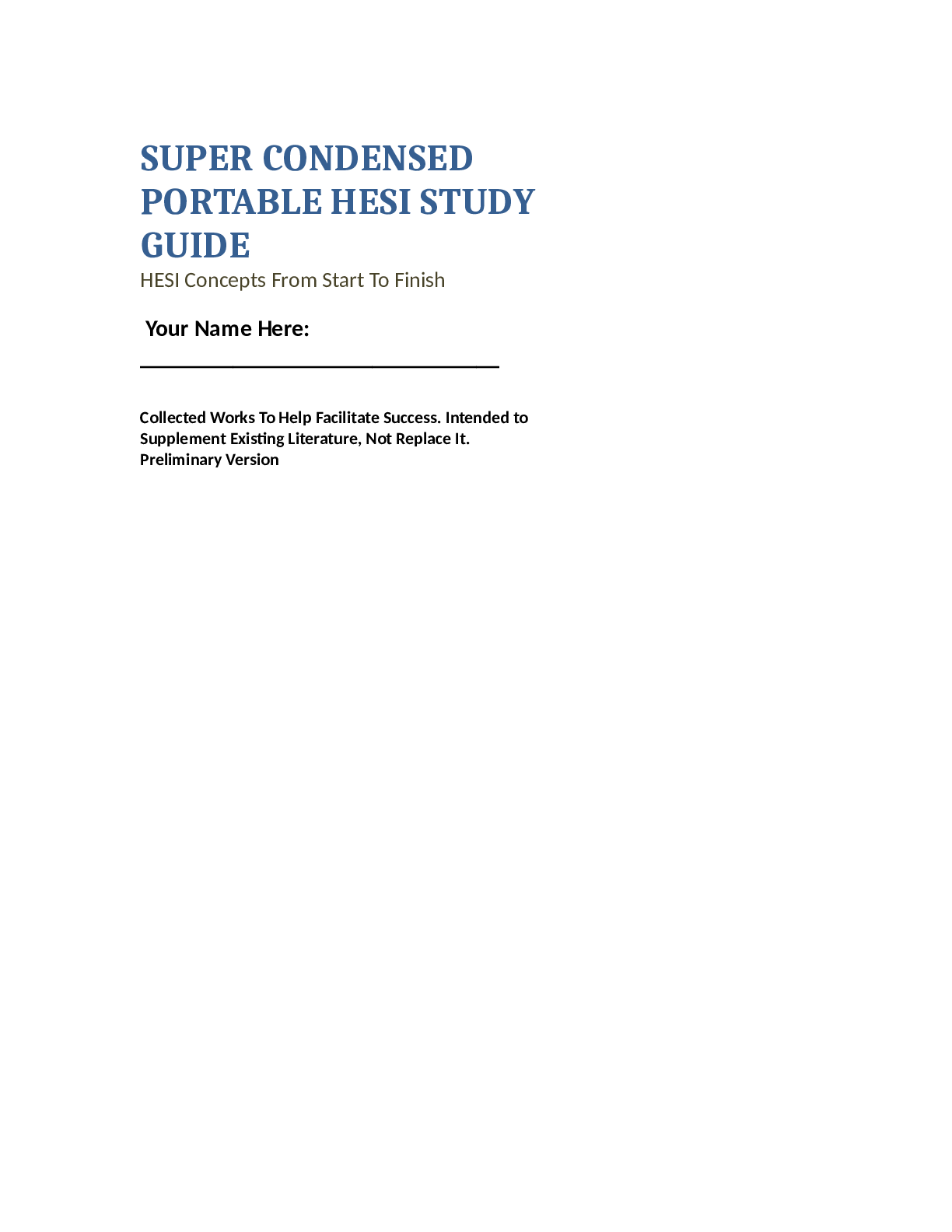




 (1).png)



